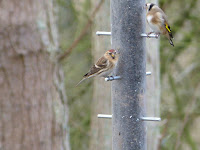 Our trip during half term did not prove fruitful in terms of waders, but it was wonderful to watch a pair of marsh harriers above the reeds at Fen hide. The woodland was very quiet for birdsong, but we were lucky to spot a tree creeper at the very end of the woodland walk. I have not seen one of these well camouflaged birds in a long time, but this individual was very obliging, returning to the very base of the tree trunk before circling its way round and up, allowing for some good observations. I noticed only afterwards that I could see its tongue in the photographs I took.
Our trip during half term did not prove fruitful in terms of waders, but it was wonderful to watch a pair of marsh harriers above the reeds at Fen hide. The woodland was very quiet for birdsong, but we were lucky to spot a tree creeper at the very end of the woodland walk. I have not seen one of these well camouflaged birds in a long time, but this individual was very obliging, returning to the very base of the tree trunk before circling its way round and up, allowing for some good observations. I noticed only afterwards that I could see its tongue in the photographs I took.The snowdrops were out in force, lighting up the woodland walkways like fairy lights. Amongst the dead wood and decaying leaves were also the vivid hues of the scarlet elf cap fungus.
Our second visit today was much later in the afternoon, in the hope of seeing more crepuscular animals. On arrival, we were told that a penduline tit had been showing well from Fen hide and if we stayed until dusk, we might be lucky enough to spot it. It was not to be, however.
The woodland walk today was much livelier than it was on our last visit, with bird song louder and more varied. A pair of coal tits hovered and hid among the upper branches of the coniferous trees, not far from where our tree creeper had been. The most surprising observation in the woodland was a seven spot ladybird perched on a trio of hazel(?) catkins. It must have ventured out during a milder spell, now trying to find a crevice to squeeze into in the chilly afternoon.
We walked back through the woodland and made our way to Fen hide. Here, we saw two marsh harriers gliding above the reed bed, then disappearing among the swaying golden fronds. At the same time, appearing from near the waterline, were Chinese water deer. They would appear and disappear silently into the reeds, with no betrayal of their loud vocalisations that we could hear only later when leaving the hide.


















